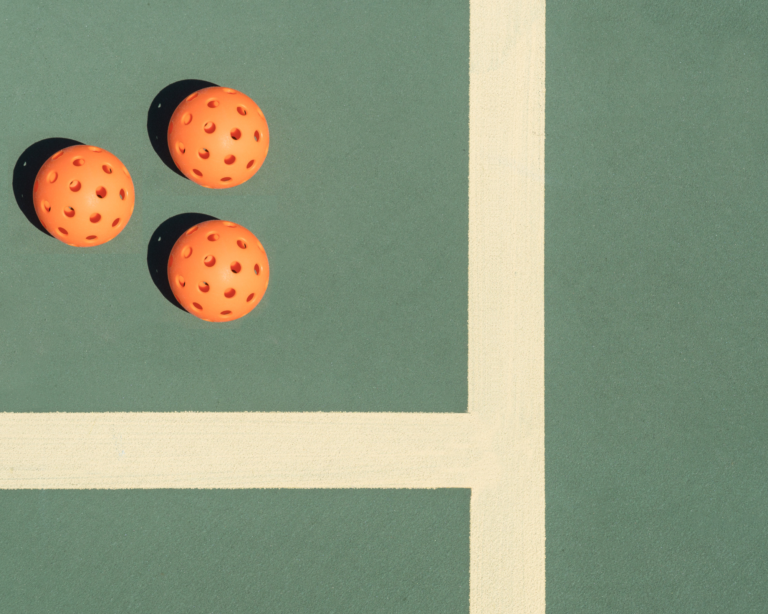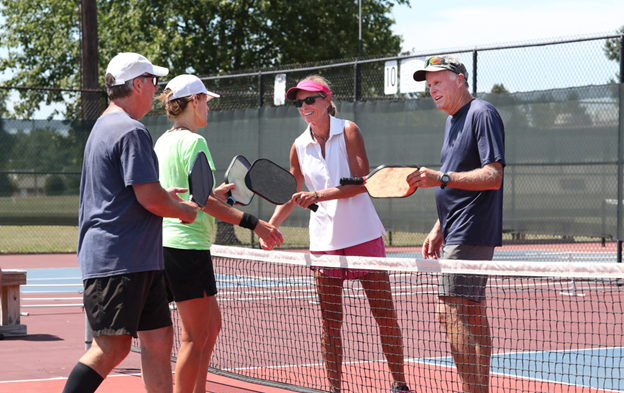
Pickleball, a sport that has gained popularity in recent years, is similar to tennis but played with a paddle and a plastic ball on a smaller court. The game can be played as singles or doubles, indoors or outdoors. Interested to learn more? This guide will provide you all the information you need to start playing and enjoying this sport.
Beginner Pickleball Terms to Know
If you’re new to the game, you may be overwhelmed by the various terms and phrases used by more experienced players. Understanding these terms is crucial to understanding the game itself.
Like tennis, there are two shots you can use in pickleball. Groundstrokes are shots that are hit after the ball has bounced on the court surface, typically hit from the baseline area of the court. Meanwhile, volleys are shots that are hit out of the air, usually when the player is closer to the net.
Other Jargons
Here are other jargons you should familiarize yourself with:
- Dink. A soft shot hit just over the net and into the non-volley zone.
- Lob. A high-arcing shot hit deep into the opponent’s court.
- Pickle. A term used to describe a tie-break game played to 11 points. It can end up to 15 points.
- Poach. When a player in doubles moves to intercept and hit a ball that their partner could have hit.
- Side out. When the serving team loses a point, resulting in a change of serve.
- Drive. A hard, offensive shot hit with power and pace.
- Topspin. A shot hit with a forward spin that causes the ball to drop quickly.
- Kitchen. The non-volley zone, a 7-foot area on both sides of the net where players cannot hit the ball out of the air.
- Erne. A shot where a player jumps over the kitchen line to hit the ball before it bounces, often used to surprise opponents.
- Non-Volley Zone. The area on both sides of the net, within 7 feet from the net, where players are not allowed to volley the ball.

Unlike tennis, the court you play pickleball in are 20 feet by 44 feet with a net 36 inches high at the center. To know more about the pickleball court, check out this article we wrote about it.
Rules of Pickleball
There are also unique rules you need to get acquainted with before starting the game.
Rule #1: Underhand Serve Only, at the Baseline
A coin toss determines the first pickleball player to serve. Players then take turns serving and can only serve from the back line of the court, using an underhand stroke from below the waist. The first server serves the ball from the right side to start the game. If you score points with this service, the server will continue serving from the left. The ball must be served along the opposite diagonal court, underhand, and at the baseline. It must also bounce once before the paddle hits it. After the ball is hit, players can move anywhere on the pickleball court.
Rule #2: No Volley in the Kitchen
Pickleball’s founders recognized that players standing near the net had an unfair advantage in volleying, which made the game less enjoyable for the defending team. This is why they created the Kitchen and prohibited players from hitting volleys while standing in that area. Without this rule, players at the net could easily hit downward smashes that put their opponents on the defensive.
If a player steps into the non-volley zone, including the line, or their momentum carries them or any item they are carrying into the non-volley zone or its associated lines while volleying a ball, it is considered a fault. Even if the volleyed ball is declared dead before this happens, it is still a fault if the player is carried by their momentum into or touches the non-volley zone after volleying.
Rule #3 Two Bounce Rule
After the serve, each team must hit the ball back and forth at least once before either team can hit the ball on the fly (i.e., without bouncing it first). In other words, the receiving team must allow the ball to bounce before returning it, and subsequently, the serving team must also let the ball bounce before returning it. Hence, there are two bounces in total. One groundstroke is required before the ball can be volleyed. This promotes longer rallies and strategic play.
Rule #4 Score by Serving, Win by 2
Only the serving team is eligible to score points. Matches are played until 11 points, with a margin of 2 points required for victory. A typical match comprises three games, and the winner must win two out of three games. In the third game, the first player to reach 5 points with a margin of 2 points wins. Furthermore, when the serving team’s score is even, the first server for that team will be positioned on the right-side court while serving or receiving. Conversely, when the serving team’s score is odd, the first server will be positioned on the left-side court while serving or receiving.
If the score is tied at 10-10, the first team to score 2 points in a row is the winning team.
Is Pickleball Difficult to Learn to Play?

Pickleball is not difficult to learn to play. It can be quite easy to pick up the basics of this sport. However, like any sport, there is a learning curve involved in becoming a skilled pickleball player. Hence, be well aware of all the rules of pickleball and you are good to go.
Pickleball is relatively new, so there aren’t as many resources available as for more established sports. However, the pickleball community is growing rapidly, and more resources are becoming available all the time. If you’re having trouble finding something, just ask around or search online. There’s a good chance someone has already created what you’re looking for.
One of the great things about pickleball is that people of all ages and skill levels can play it. Whether you’re a beginner or a seasoned pro, there’s always a place for you on the court. So don’t be discouraged if you don’t pick up the sport right away. You’ll play like a pro in no time with a bit of practice!
Is Pickleball a Safe Sport to Play?

Pickleball is a great way to stay active and have fun at the same time. You can also play the game indoors or outdoors, making it an excellent option for all kinds of weather. The game is also a great way to socialize and meet new people.
In addition to being a fun workout, pickleball can help improve your flexibility and hand-eye coordination. It is also a low-impact sport, so it’s easy on your joints. While the sport has some inherent risks, these can be minimized by following simple safety precautions.
One of the most important things to do when playing pickleball is to wear the proper safety gear, including eye protection, gloves, and appropriate footwear. Eye protection is critical, as the small pickleball can travel at high speeds and cause serious eye injuries.
Another safety precaution when pickleball is played is to be aware of your surroundings, including other players and objects on the court that could pose a hazard. For example, if there are trees or other obstacles near the court, keep an eye out for them to avoid accidentally hitting them with the ball.
Finally, it’s essential to warm up properly before playing pickleball to help reduce the risk of injury and make the game more enjoyable. A good warm-up should include some light stretching and cardio exercises.
Overall, pickleball is a safe sport as long as players take the proper precautions. By wearing the appropriate gear, being aware of your surroundings, and warming up properly, you can help reduce the risks associated with the game.